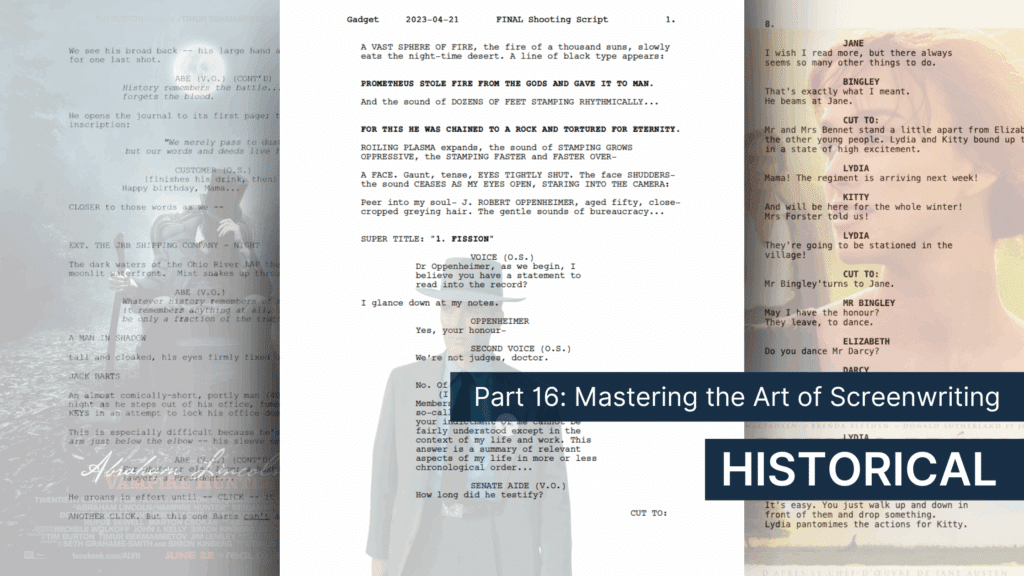
Greetings and salutations! Welcome to the latest blog in our Mastering the Art of Screenwriting series. We’re glad you are here. Today’s installment is all about period pieces and how you can write your very own punchy historical scripts!
Downton Abbey and Bridgerton have become permanent fixtures in today’s culture, and that’s no fluke! There’s something timelessly captivating about a good period piece.

From the meticulous detail of Victorian England to the muddy battlefields of World War II and the candlelit intrigue of the French Revolution, historical scripts give us a chance to transport to another time while consuming stories that still resonate today. It’s no wonder that screenwriters still gravitate towards period stories.
However, writing a historical script involves a great deal more than dusting off some old books and throwing in a few corsets. We must also put in extensive research, creativity, and a deep respect for the era we’re exploring.
But never fear, because in today’s blog post we’ll unpack what it really means to write a historical script, how to choose your era and genre, and how to blend fact with fiction in your quest to keep your audience engaged.
As always, we’ll throw in some stellar examples of historical storytelling, and how tools like Celtx can make your writing process smoother and more structured.
So, step inside the Celtx time machine…
Table of Contents
- What is a Historical Script?
- Choosing Your Era and Genre
- Different Types of Historical Scripts
- Research and Authenticity
- Examples Across Genres
- Try Celtx’s Structure and Planning Tools
- Conclusion
What is a Historical Script?
A historical script is any screenplay set in a past time period, often inspired by real events, people, or cultures.
They aim to capture the essence of a specific era while telling an engaging story that either mirrors historical truth or plays imaginatively with it.

Historical scripts come in all shapes and sizes, from deeply researched biopics to wild genre mashups that only use history as a springboard into a whole new world. What they do all have in common is a clear focus on setting, culture, and historical context.
It is easy to mistake ‘old-timey’ stories for historical, but they aren’t always! For a script to qualify as historical, the history needs to be more than just background dressing and should influence the characters, plot, and the world’s rules.
Writing a historical epic — or a minimalist chamber piece? Celtx’s script writing software adapts to your story, no matter the scale.
Click here to get started!
Choosing Your Era and Genre
Okay, so let’s get into the good stuff: writing!
The first decision you’ll make before you pick up your pen or start typing is choosing when your story takes place.
It’s wise to pick an era of history you’re naturally drawn to personally. Are you interested in the drama or the Renaissance, the grit of the Great Depression or the glamor and politics or 18th-century France? Or something else entirely?
Once you have an idea of what era you’d like to explore, ask yourself these three questions:
- What fascinates you about this era?
- What kinds of conflicts naturally occurred in this time period?
- Are there untold or underrepresented stories worth exploring?
Try to be specific in your answers to help you boil down your story to its core.
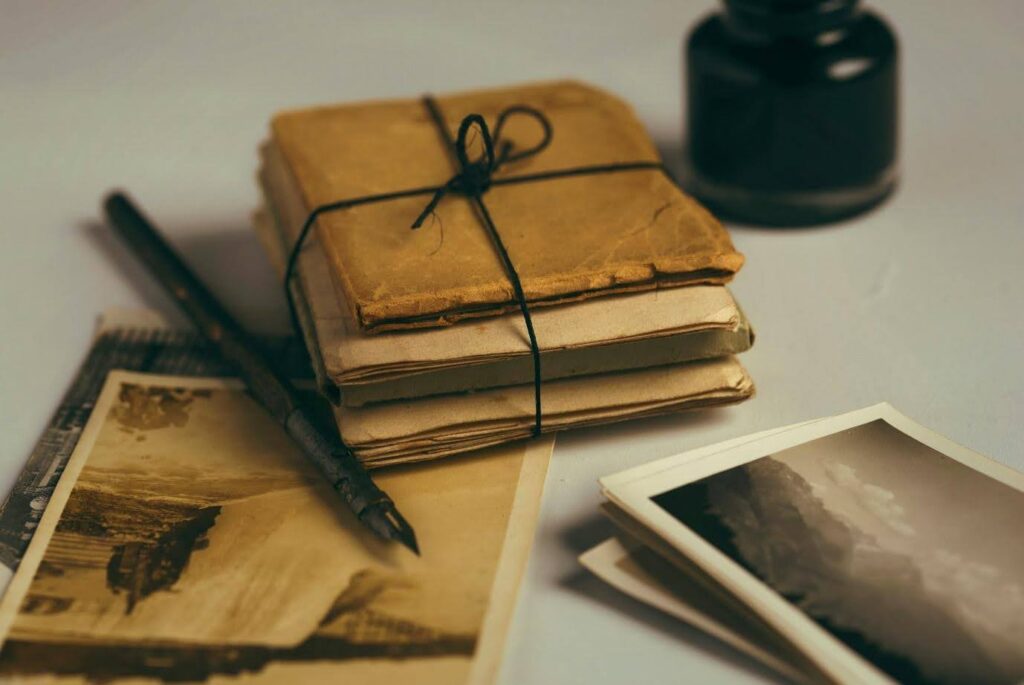
Equally important is the genre you choose. Historical stories aren’t limited to just dramas and biopics. In fact, some of the most innovative scripts blend history with unexpected genres to create something audiences have never seen before. For example:
- Historical Horror (where the eerie supernatural meets old-world fears)
- Historical Romance (where emotions run high against rigid societal norms)
- Historical War Film (where action meets emotional intensity)
- Historical Mystery/Thriller (where conspiracies and past secrets collide)
Pairing a specific era with a popular genre gives your script structure, tone, and direction. For example, a 1920s noir mystery has a vastly different aesthetic and rhythm than a medieval horror.
Different Types of Historical Scripts
Let’s take a closer look at the broad categories that historical scripts typically fall into, to garner some inspiration!
1. Historical Fiction
Historical fiction scripts are perhaps the most flexible as they use real historical settings and often actual events or figures. The main narrative and characters are invented.
The goal is to stay true to the era while giving yourself room to tell an interesting story.
Think Titanic where the sinking is real, but Jack and Rose are fictional. Or The Last Samurai which explores a fictional journey through a real historical transition in Japan.
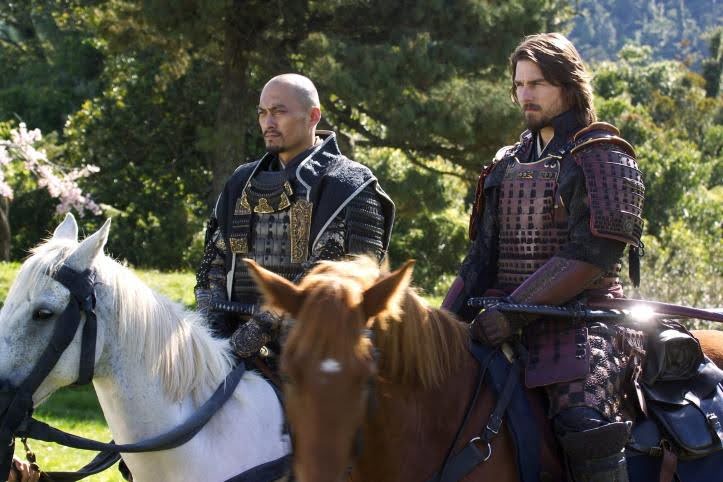
2. Period Drama
Here, the stakes are all about people. Period dramas emphasize character relationships, societal pressures, and internal conflict.
The period setting shapes the characters’ options, behaviors, and values just like The Crown which follows real monarchs but leans heavily into dramatized emotions and personal relationships. The same goes for Atonement, where deeply emotional storytelling is rooted in pre- and post-World War II England.
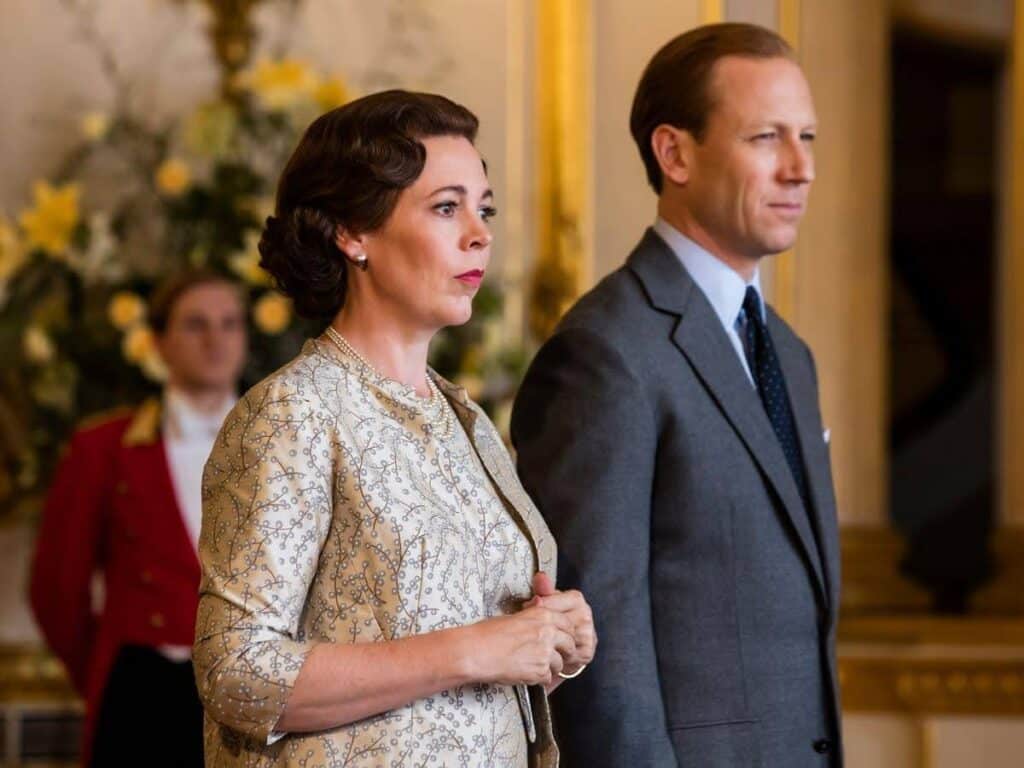
3. Historical Biography/Biopic
In biopics, the focus is on a real person’s life, often emphasizing their historical significance. These scripts are the ones that require rigorous research and a careful balance of dramatization and truth.
Movies like Oppenheimer give us an intense look into the life of a man behind the atomic bomb, while Lincoln is a deep dive into a president’s leadership during a turning point in history.
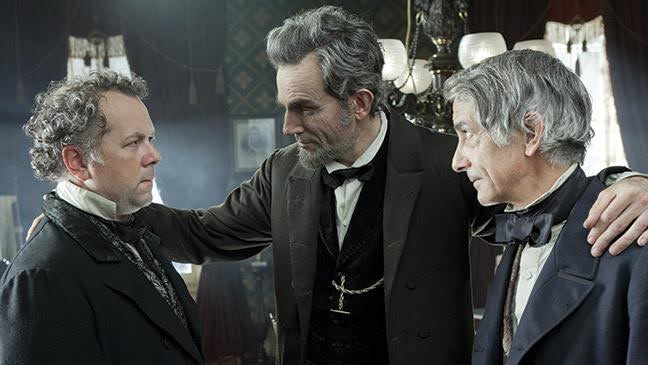
4. Alternative History/Genre Fusion
This is where writers really experiment! Scripts like these often take liberties with historical events or infuse the narrative with speculative elements.
Abraham Lincoln: Vampire Hunter is a horror-meets-history extravaganza set in an alternate America while Inglourious Basterds is a brutal reimagining of World War II with Tarantino’s signature flair.
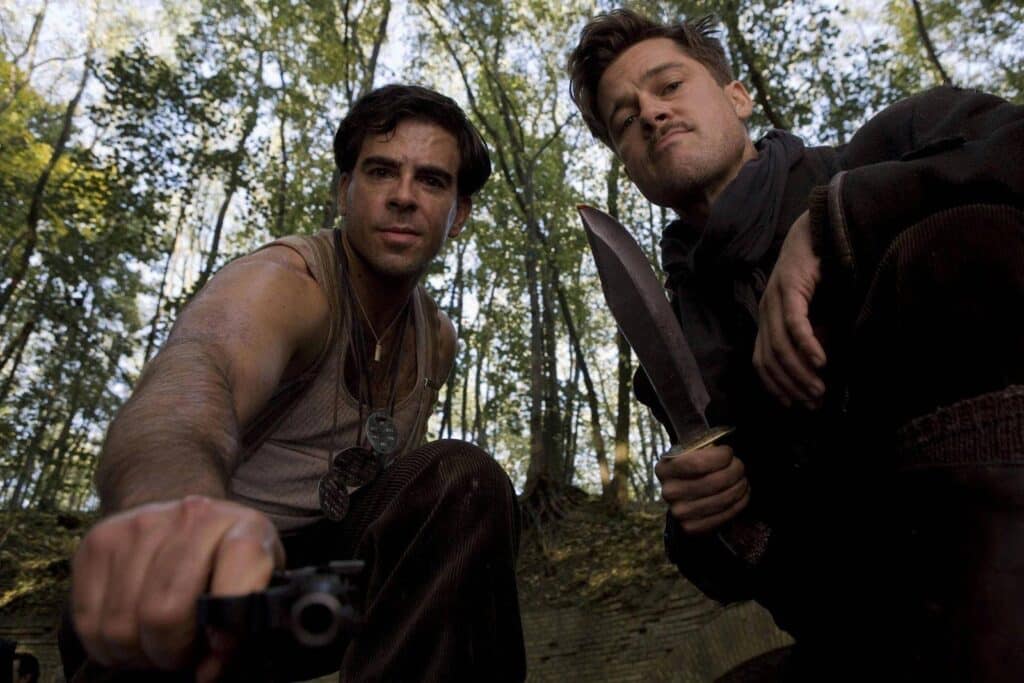
Need help keeping your period-accurate plot on track? Use Celtx’s Beat Sheet tool to map out your story from exposition to resolution.
Click here to try it – it’s free!
Research and Authenticity
Research should be the backbone of any script, especially if you’re looking to write a historical one. Even when you’re bending facts or adding fictional elements, your script still needs to feel authentic.
In short, you need to understand the customs, politics, social norms, and language of the time.
When you first start researching for your screenplay, start with these basics:
- Historical timeline (know the key events of your chosen era)
- Language and dialect (decide how formal or accurate your dialogue needs to be)
- Costumes and props (what people wear, and use tells us a lot about who they are)
- Cultural norms (gender roles, class structures, and everyday life all matter)
But what research materials can you use? Well, we recommend using primary sources where possible. Things like letters, newspapers, court records. Don’t rely solely on Wikipedia!
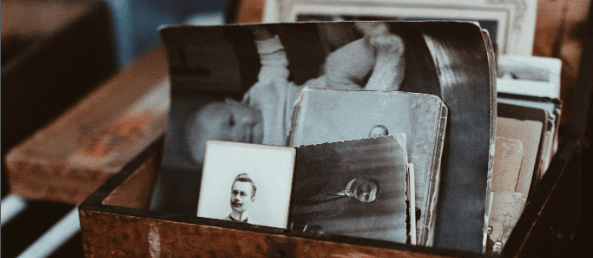
Yes, we know we’ve harped on about research, but don’t let accuracy kill your momentum. Great storytelling sometimes means bending history to serve a theme or character.
The crux of it is to make your world feel lived-in and credible, even if every detail isn’t 100% accurate.
Examples Across Genres
Need some inspiration to get started on your period script? Here’s how various genres have tackled historical storytelling:
Horror | Abraham Lincoln: Vampire Hunter (2012)
This mashup of horror and history delivers outrageous entertainment by taking a real-life figure and giving him a supernatural twist. This 2012 hit movie is a great example of how bold creative risks can breathe new life into familiar history, when executed well!
What Abraham Lincoln: Vampire Hunter teaches us is not to be afraid to get weird. Genre fusion can open up wildly original possibilities for historical scripts.
Pure Historical | Oppenheimer (2023)
Christopher Nolan’s Oppenheimer is a masterclass in historical storytelling that doesn’t flinch from their complex natures. It explores ethical dilemmas, scientific ambition, and political paranoia, all rooted in deeply researched history.
With Oppenheimer, Nolan uses structure (such as nonlinear timelines) to enhance theme and character development.
War | Dunkirk (2017) & Saving Private Ryan (1998)
Dunkirk immerses the audience in the chaos and emotion of World War II, playing with time and perspective.
Meanwhile, Saving Private Ryan focuses on a specific rescue mission with brutal realism.
War movies like these usually benefit from immersive realism, high stakes, and emotional clarity.
Romance | Pride & Prejudice (2005)
This Jane Austen adaptation is proof that historical romance can be both emotional and socially insightful. The period setting creates high-stakes barriers to love, making each glance or word charged with meaning.
Historical romances like Pride and Prejudice use their historical restrictions to heighten emotional tension and deepen their character arcs.
Crime/Thriller | Peaky Blinders (2013-2022)
Set in post-World War I Birmingham, Peaky Blinders blends historical grit with gripping crime drama. While the Shelby family is fictional, many of the events and political tensions, such as the rise of communism, fascism, and Irish nationalism, are rooted in historical reality.
The show’s visual style, music, and pacing give it a modern energy without sacrificing period authenticity.
Try Celtx’s Structure and Planning Tools
Did you know that Celtx is here to help with all your screenwriting needs? Yes!
However, our offering is so much more than screenwriting software. It’s a complete pre-production toolkit and is especially helpful for organizing complex historical scripts.
Okay, so how does Celtx support your process?
1. Story Development Tools
Use our index cards, beat board, and story map features to outline your script scene by scene. These are invaluable when balancing character arcs with real historical events in your period script.
2. Character Development
Track your characters’ motivations and evolution through history. Celtx allows you to create detailed character bios, which is especially helpful when dealing with period-specific traits and behaviors.
3. World-Building
Historical scripts require a lot of world-building. Use Celtx’s production catalog to map locations, log research notes, and keep costume and set ideas in one place!
4. Collaboration
If you’re collaborating with a historian, co-writer, or producer, Celtx’s collaboration tools make it easy to share updates, feedback, and changes in real time.
5. Script Formatting
The best part is that Celtx automatically formats your script to industry standards, so you can focus on creativity without worrying about technical details.
Conclusion
Writing a historical script is a rewarding challenge. It invites you to merge your love of story with a passion for the past, crafting characters who live and breathe within a fully realized world. Whether you’re telling a grounded tale based on real events or crafting a genre-bending adventure with vampires and muskets, the key is authenticity with intention.
Choose your era with care. Let the genre shape your narrative. Do your homework, but don’t let it stifle your voice. Lean into tools like Celtx to stay organized and focused. And most importantly, remember that history isn’t just a backdrop, but it’s a character all its own.
So go ahead, Dear Reader — put on your writer’s powdered wig, grab a quill (or keyboard), and start creating period pieces with a punch.
Write a script in any genre with our screenwriting series:
- Part 1: Introduction: Mastering the Art of Screenwriting
- Part 2: From Dreams to Screams: How to Write a Horror Script
- Part 3: From Dreams to Screams: How to Write a Horror Script Part 2
- Part 4: Beyond the Stars: How to Write a Science Fiction Script
- Part 5: Laugh Out Loud: How to Write a Comedy Script
- Part 6: From Tears to Triumphs: How to Write a Drama Script
- Part 7: From Meet-Cutes to Happy Endings: How to Write a Rom-Com Script
- Part 8: Crafting Magic: How to Write a Holiday Movie Script
- Part 9: How to Write a Documentary Script: A Step-by-Step Guide
- Part 10: How to Write a Skit That Lands Every Time
- Part 11: How to Write a Romance Script that Sweeps Audiences Away
- Part 12: From Clues to Conclusions: How to Write a Mystery Script
- Part 13: From Song to Stage: How to Write a Musical Script
- Part 14: From Zero to Hero: How to Write an Action Movie Script
- Part 15: Legacy and Lore: How to Write a Fantasy Script
